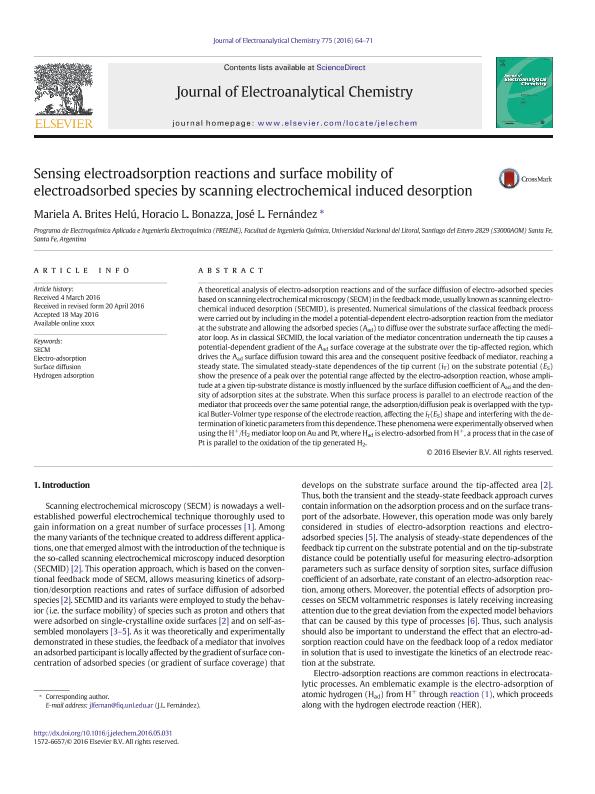Mostrar el registro sencillo del ítem
dc.contributor.author
Brites Helú, Mariela Alicia

dc.contributor.author
Bonazza, Horacio

dc.contributor.author
Fernandez, Jose Luis

dc.date.available
2017-06-21T20:43:36Z
dc.date.issued
2016-08
dc.identifier.citation
Brites Helú, Mariela Alicia; Bonazza, Horacio; Fernandez, Jose Luis; Electro-adsorption reactions and surface mobility of electro-adsorbed species sensed by scanning electrochemical induced desorption; Elsevier Science Sa; Journal Of Electroanalytical Chemistry; 775; 8-2016; 64-71
dc.identifier.issn
1572-6657
dc.identifier.uri
http://hdl.handle.net/11336/18594
dc.description.abstract
A theoretical analysis of electro-adsorption reactions and of the surface diffusion of electro-adsorbed species based on scanning electrochemical microscopy (SECM) in the feedback mode, usually known as scanning electrochemical induced desorption (SECMID), is presented. Numerical simulations of the classical feedback process were carried out by including in the model a potential-dependent electro-adsorption reaction from the mediator at the substrate and allowing the adsorbed species (Aad) to diffuse over the substrate surface affecting the mediator loop. As in classical SECMID, the local variation of the mediator concentration underneath the tip causes a potential-dependent gradient of the Aad surface coverage at the substrate over the tip-affected region, which drives the Aad surface diffusion toward this area and the consequent positive feedback of mediator, reaching a steady state. The simulated steady-state dependences of the tip current (iT) on the substrate potential (ES) show the presence of a peak over the potential range affected by the electro-adsorption reaction, whose amplitude at a given tip-substrate distance is mostly influenced by the surface diffusion coefficient of Aad and the density of adsorption sites at the substrate. When this surface process is parallel to an electrode reaction of the mediator that proceeds over the same potential range, the adsorption/diffusion peak is overlapped with the typical Butler-Volmer type response of the electrode reaction, affecting the iT(ES) shape and interfering with the determination of kinetic parameters from this dependence. These phenomena were experimentally observed when using the H+/H2 mediator loop on Au and Pt, where Had is electro-adsorbed from H+, a process that in the case of Pt is parallel to the oxidation of the tip generated H2.
dc.format
application/pdf
dc.language.iso
eng
dc.publisher
Elsevier Science Sa

dc.rights
info:eu-repo/semantics/openAccess
dc.rights.uri
https://creativecommons.org/licenses/by-nc-nd/2.5/ar/
dc.subject
Secm
dc.subject
Electro-Adsorption
dc.subject
Surface Diffusion
dc.subject
Hydrogen Adsorption
dc.subject.classification
Físico-Química, Ciencia de los Polímeros, Electroquímica

dc.subject.classification
Ciencias Químicas

dc.subject.classification
CIENCIAS NATURALES Y EXACTAS

dc.title
Electro-adsorption reactions and surface mobility of electro-adsorbed species sensed by scanning electrochemical induced desorption
dc.type
info:eu-repo/semantics/article
dc.type
info:ar-repo/semantics/artículo
dc.type
info:eu-repo/semantics/publishedVersion
dc.date.updated
2017-06-08T19:27:58Z
dc.journal.volume
775
dc.journal.pagination
64-71
dc.journal.pais
Países Bajos

dc.description.fil
Fil: Brites Helú, Mariela Alicia. Universidad Nacional del Litoral. Facultad de Ingeniería Química. Programa de Electroquímica Aplicada E Ingeniería Electroquímica; Argentina. Consejo Nacional de Investigaciones Científicas y Técnicas; Argentina
dc.description.fil
Fil: Bonazza, Horacio. Consejo Nacional de Investigaciones Científicas y Técnicas. Centro Científico Tecnológico Conicet - Santa Fe. Instituto de Desarrollo Tecnológico Para la Industria Química. Universidad Nacional del Litoral. Instituto de Desarrollo Tecnológico Para la Industria Química; Argentina
dc.description.fil
Fil: Fernandez, Jose Luis. Universidad Nacional del Litoral. Facultad de Ingeniería Química. Programa de Electroquímica Aplicada E Ingeniería Electroquímica; Argentina. Consejo Nacional de Investigaciones Científicas y Técnicas; Argentina
dc.journal.title
Journal Of Electroanalytical Chemistry

dc.relation.alternativeid
info:eu-repo/semantics/altIdentifier/doi/http://dx.doi.org/10.1016/j.jelechem.2016.05.031
dc.relation.alternativeid
info:eu-repo/semantics/altIdentifier/url/http://www.sciencedirect.com/science/article/pii/S1572665716302624
Archivos asociados
